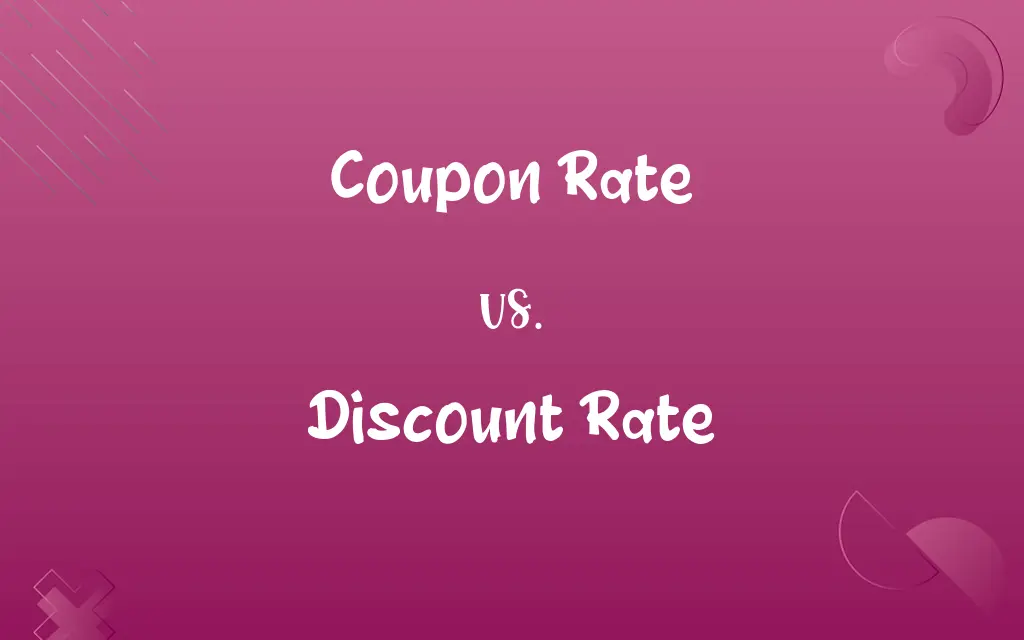Coupon Rate vs. Discount Rate: Know the Difference

By Shumaila Saeed || Published on February 3, 2024
Coupon Rate is the interest rate a bond issuer pays its holders, while Discount Rate is the interest rate charged by central banks on loans to commercial banks.

Key Differences
Coupon Rate refers to the annual interest rate paid on a bond, expressed as a percentage of the face value. It determines the periodic interest payments made to bondholders. Conversely, the Discount Rate is the interest rate set by central banks, which is used for lending to financial institutions. This rate is pivotal in influencing monetary policy and financial stability.
Shumaila Saeed
Feb 03, 2024
When discussing Coupon Rate, it's crucial to understand that it's fixed upon issuance and dictates the bond's yield. This rate is integral in calculating the regular income a bond will provide. In contrast, the Discount Rate serves as a tool for central banks to control liquidity and manage the supply of money in the economy, impacting overall lending and borrowing rates.
Shumaila Saeed
Feb 03, 2024
The Coupon Rate directly affects the attractiveness of a bond to investors, as it impacts their return on investment. A higher coupon rate typically indicates a higher yield. On the other hand, the Discount Rate influences the cost of borrowing for banks and, subsequently, the rates they offer to customers, affecting consumer loans and mortgages.
Shumaila Saeed
Feb 03, 2024
In the context of Coupon Rate, the focus is primarily on investment income and bond market dynamics. Investors consider this rate when assessing the potential income from bond investments. Conversely, the Discount Rate is more focused on macroeconomic factors, playing a crucial role in central bank policies and the broader financial market health.
Shumaila Saeed
Feb 03, 2024
Finally, while the Coupon Rate is important for individual investors and bond issuers, the Discount Rate holds significance for the banking sector and the overall economy. It's a reflection of the central bank's stance on monetary policy, whereas the coupon rate represents the fixed income a bond will generate over its lifetime.
Shumaila Saeed
Feb 03, 2024
ADVERTISEMENT
Comparison Chart
Definition
Interest rate paid by bonds to holders
Interest rate central banks charge on loans to banks
Shumaila Saeed
Feb 03, 2024
Purpose
Determines bond's periodic interest payments
Influences monetary policy and bank lending rates
Shumaila Saeed
Feb 03, 2024
Fixed or Variable
Fixed upon bond issuance
Can vary based on central bank policies
Shumaila Saeed
Feb 03, 2024
Primary Concern
Investment return and bond yield
Monetary stability and control of money supply
Shumaila Saeed
Feb 03, 2024
ADVERTISEMENT
Coupon Rate and Discount Rate Definitions
Coupon Rate
The percentage rate of interest paid by bond issuers to investors.
Her bond has a coupon rate of 6%, so she receives $60 each year on her $1,000 investment.
Shumaila Saeed
Jan 24, 2024
Discount Rate
The rate at which financial institutions borrow short-term funds from the central bank.
Lowering the discount rate, the central bank aimed to encourage more lending and stimulate economic growth.
Shumaila Saeed
Jan 24, 2024
Coupon Rate
The annual interest rate paid on a bond's face value.
A bond with a face value of $1,000 and a coupon rate of 5% will pay $50 annually.
Shumaila Saeed
Jan 24, 2024
Discount Rate
The rate impacting the cost of borrowing for banks and their lending policies.
An increase in the discount rate led to banks raising interest rates on loans and credit cards.
Shumaila Saeed
Jan 24, 2024
Coupon Rate
The yield percentage a bond issuer promises to pay bondholders.
An investor bought a bond with a 4% coupon rate, expecting to earn $40 yearly on a $1,000 investment.
Shumaila Saeed
Jan 24, 2024
ADVERTISEMENT
Discount Rate
A tool for monetary policy used to influence banking sector liquidity.
To curb inflation, the central bank hiked the discount rate, tightening the money supply.
Shumaila Saeed
Jan 24, 2024
Coupon Rate
The rate at which a bond's issuer pays interest to holders.
A corporate bond with a 7% coupon rate yields $70 annually on its $1,000 face value.
Shumaila Saeed
Jan 24, 2024
Discount Rate
The interest rate charged by central banks for lending to commercial banks.
The central bank raised the discount rate to 5%, making borrowing more expensive for banks.
Shumaila Saeed
Jan 24, 2024
Coupon Rate
A fixed rate determining the periodic income from a bond.
The bond's coupon rate of 3% ensures a steady income of $30 per year for each $1,000 invested.
Shumaila Saeed
Jan 24, 2024
Discount Rate
A reference rate for determining lending rates in the broader economy.
When the discount rate was reduced, banks passed on the lower rates to consumers through decreased mortgage rates.
Shumaila Saeed
Jan 24, 2024
Repeatedly Asked Queries
What does the Discount Rate represent?
It's the interest rate central banks charge on loans to commercial banks.
Shumaila Saeed
Feb 03, 2024
Why is the Discount Rate important in monetary policy?
It influences the cost of borrowing in the economy and helps control money supply.
Shumaila Saeed
Feb 03, 2024
How does the Coupon Rate affect bond investments?
It determines the periodic income an investor earns from a bond.
Shumaila Saeed
Feb 03, 2024
Can the Coupon Rate change over the life of a bond?
No, it's fixed at issuance and remains constant throughout the bond's life.
Shumaila Saeed
Feb 03, 2024
What is a Coupon Rate?
It's the annual interest rate paid by bonds to their holders, based on the bond's face value.
Shumaila Saeed
Feb 03, 2024
Does the Discount Rate affect individual consumers?
Indirectly, as it influences the rates banks offer on loans and deposits.
Shumaila Saeed
Feb 03, 2024
What happens when the Coupon Rate is high?
Bonds become more attractive to investors, offering higher returns.
Shumaila Saeed
Feb 03, 2024
How do central banks decide on the Discount Rate?
It's based on economic conditions and monetary policy goals.
Shumaila Saeed
Feb 03, 2024
Is the Coupon Rate the same for all bonds?
No, it varies depending on the bond issuer and market conditions.
Shumaila Saeed
Feb 03, 2024
Is the Discount Rate the same worldwide?
No, each central bank sets its own rate based on local economic needs.
Shumaila Saeed
Feb 03, 2024
How does a change in the Discount Rate affect the banking system?
It impacts banks' cost of capital and influences their lending and deposit rates.
Shumaila Saeed
Feb 03, 2024
Are Coupon Rates relevant to short-term investments?
They are more pertinent to medium and long-term bond investments.
Shumaila Saeed
Feb 03, 2024
Why would an investor consider a bond's Coupon Rate?
To assess the potential return and income from the bond investment.
Shumaila Saeed
Feb 03, 2024
Does the Coupon Rate affect a bond's market price?
Yes, it can influence the bond's demand and market value.
Shumaila Saeed
Feb 03, 2024
Can Coupon Rates vary across different countries?
Yes, they depend on the issuing entity and the country's economic conditions.
Shumaila Saeed
Feb 03, 2024
What role does the Discount Rate play during economic crises?
It's often adjusted to stabilize the economy and support financial institutions.
Shumaila Saeed
Feb 03, 2024
How is the Discount Rate related to inflation?
It's used as a tool to control inflation by affecting borrowing costs.
Shumaila Saeed
Feb 03, 2024
What impact does a low Coupon Rate have on bonds?
It may make them less attractive to investors seeking higher yields.
Shumaila Saeed
Feb 03, 2024
Why might a central bank lower the Discount Rate?
To stimulate economic growth by making borrowing cheaper for banks.
Shumaila Saeed
Feb 03, 2024
Can commercial banks influence the Discount Rate?
No, it's set by the central bank and is beyond the control of commercial banks.
Shumaila Saeed
Feb 03, 2024
Share this page
Link for your blog / website
HTML
Link to share via messenger
About Author
Written by
Shumaila SaeedShumaila Saeed, an expert content creator with 6 years of experience, specializes in distilling complex topics into easily digestible comparisons, shining a light on the nuances that both inform and educate readers with clarity and accuracy.

































































